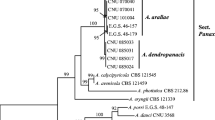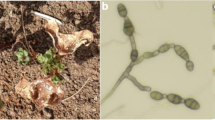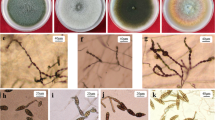Abstract
This is the first report of Alternaria leaf spot disease on coriander (Coriandrum sativum L.) in South Africa. Using the agar plate method, Alternaria alternata was isolated from coriander seed lots together with four other fungal genera, which included Aspergillus, Fusarium, Penicillium and Rhizopus. Standard seed germination tests of coriander seed lots infected with seed-borne mycoflora showed a positive correlation with the number of diseased seedlings (r = 0.239, p < 0.01). Pathogenicity tests demonstrated that this seed-borne A. alternata was pathogenic on coriander and symptoms on leaves first appeared as small, dark brown to black, circular lesions (<5 mm diam.) that enlarged and coalesced to form dark brown blotches as time progressed. Leaf spot disease was most severe (64%) on wounded leaves inoculated with A. alternata. Re-isolation of A. alternata from diseased coriander plants satisfied the Koch’s postulates, thus confirming it as the causal agent of Alternaria leaf spot disease. Parsimony analysis based on rpb2 (GenBank Accession No. KT895947), gapdh (KT895949) and tef-1α (KT895945) sequences confirmed identity of the Alternaria isolate, which grouped within the A. alternata clade. Alternaria alternata was shown to be transmitted from infected coriander seed to the developing plants.


Similar content being viewed by others
References
Basak, A. B., & Lee, M. W. (2002). Prevalence and transmission of seed-borne fungi of maize grown in a farm of Korea. Mycobiology, 30, 47–50.
Berbegal, M., López-Cortés, I., Salazar, D., Gramaje, D., Pérez-Sierra, A., Garcia-Jiménez, J., & Armengol, J. (2014). First report of Alternaria black spot of pomegranate caused by Alternaria alternata in Spain. Plant Disease, 98, 689.
Bihon, W., Cloete, M., Gerrano, A., Adebola, P., & Oelofse, D. (2015). First report of Alternaria alternata causing leaf blight of onion in South Africa. Plant Disease, 99, 1652.
Blodgett, J. T., & Swart, J. W. (2002). Infection, colonization, and disease of Amaranthus hybridus leaves by the Alternaria tenuissima group. Plant Disease, 86, 1199–1205.
Brasier, C. M. (2008). The biosecurity threat to the UK and global environment from international trade in plants. Plant Pathology, 57, 792–808.
Burgess, L. W., Summerell, A. B., Bullock, S., Gott, K. P., & Backhouse, D. (1994). Laboratory manual for Fusarium research (3rd ed.). Sydney: University of Sydney/Royal Botanic Gardens.
Cai, Z. Y., Liu, Y. X., Li, G. H., Wang, Y. F., & Zhou, M. (2015). First report of Alternaria alternata causing black leaf spot of rubber tree in China. Plant Disease, 99, 290.
Crous, P. W., Verkley, G. J. M., & Groenewald, J. Z. (Eds.). (2009). Fungal biodiversity. CBS laboratory manual series 1. Utrecht, Netherlands: CBS-KNAW Fungal Biodiversity Centre.
Czajka, A., Czubatka, A., Sobolewski, J., & Robak, J. (2015). First report of Alternaria leaf spot caused by Alternaria alternata on spinach in Poland. Plant Disease, 99, 729.
Dwivedi, M., Agrawal, K., & Agrawal, M. (2006). Fungi associated with coriander seeds grown in Rajasthan and their phytopathological effects. Journal of Phytological Research, 19, 125–129.
Ellis, B. M., & Ellis, J. P. (1997). Microfungi on land plants: An identification handbook, new (enlarged ed.). Slough: Richmond Publishing.
Fairey, D. T., Loch, D. S., Hampton, J. G., & Ferguson, J. E. (Eds.). (1999). Forage seed production tropical and subtropical species. Australia: CABI.
Fakhrunnisa, M. H., & Ghaffar, A. (2006). Seed-borne mycoflora of wheat, sorghum and barley. Pakistan Journal of Botany, 38, 185–192.
Hashmi, M. H., & Ghaffar, A. (1991a). Phoma multirostrata on coriander in Pakistan. Pakistan Journal of Botany, 23, 127–130.
Hashmi, M. H., & Ghaffar, A. (1991b). Seed-borne mycoflora of Coriandrum sativum L. Pakistan Journal of Botany, 23, 165–172.
International Seed Federation. (2017). Rules and usages for the trade in seeds for sowing purposes. Available at: www.iccbooks.com. Accessed 14 November 2014.
ISTA (International Seed Testing Association). (2017). International Rules for Seed Testing. Proceedings of the international seed testing association. In Bassersdorf. Switzerland: Seed Science and Technology.
Khare, M. N., Tiwari, S. P., & Sharma, Y. K. (2017). Disease problems in the cultivation of coriander (Coriandrum sativum L.) and their management leading to production of high quality pathogen free seed. International Journal of Seed Spices, 7, 1–7.
Leslie, F. J., & Summerell, A. B. (2006). The Fusarium laboratory manual. Ames, Iowa, USA: Blackwell Publishing.
Mathur, B. S., & Kongsdal, O. (2003). Common laboratory seed health testing methods for detecting fungi. Bassersdorf, Switzerland: ISTA.
Meena, R. K., Sharma, S. S., & Meena, S. C. (2013). Studies on host range and seed transmission nature of Alternaria alternata (Fr.) Keissler causing leaf blight of Isabgol. Journal of Biopesticides, 6, 112.
Neergaard, P. (1969). Seed-borne diseases: Inspection for quarantine in Africa. Copenhagen, Denmark: The Danish Government Institute of Seed Pathology.
Perelló, A. E., & Larrán, S. (2013). Nature and effect of Alternaria spp. complex from wheat grain on germination and disease transmission. Pakistan Journal of Botany, 45, 1817–1824.
Phahlane, H. (2013). South African trade. Markets and Economic Research Centre International Trade. PRO, 46, 41–52.
Raghunath, T. (1963). A new species of Alternaria causing blight of Coriandrum sativum L. Mycopathologia, 21, 315–317.
SADC Trade (2014). Trade information brief of spices. http://www.sadctrade.org/files/TIB-Spices-final.pdf. Accessed 21 October 2014.
SAS Institute. (2010). Analysis software/stat software version 9.3 for Windows. Cary, NC: SAS institution Inc., Cary NC North Carolina, USA.
Serdani, M., Kang, J. C., Andersen, B., & Crous, P. W. (2002). Characterisation of Alternaria species-groups associated with core rot of apples in South Africa. Mycological Research, 106, 561–569.
Swofford, D. L. (2002). PAUP*: Phylogenetic analysis using parsimony (*and other methods). Version 4.0b10. Sunderland, MA: Sinauer Associates.
Toben, H. M., & Rudolph, K. (1996). Pseudomonas syringae pv. coriandricola, incitant of bacterial umbel blight and seed decay of coriander (Coriandrum sativum L.) in Germany. Journal of Phytopathology, 144, 169–178.
Van der Waals, J. E., Pitsi, B. E., Marais, C., & Wairuri, C. K. (2011). First report of Alternaria alternata causing leaf blight of potatoes in South Africa. Plant Disease, 95, 363.
Vu, A. L., Dee, M. M., Russell, T., Zale, J., Gwinn, K. D., & Ownley, B. H. (2012). First report of leaf spot caused by Alternaria alternata on switchgrass in Tennessee. Plant Disease, 96, 763.
Woudenberg, J. H. C., Groenewald, J. Z., Binder, M., & Crous, P. W. (2013). Alternaria redefined. Studies in Mycology, 75, 171–212.
Woudenberg, J. H. C., Seidl, M. F., Groenewald, J. Z., De Vries, M., Stielow, J. B., Thomma, B. P. H. J., & Crous, P. W. (2015). Alternaria section Alternaria: Species, formae speciales or pathotypes? Studies in Mycology, 82, 1–2.
Yago, J. I., Roh, J. H., Bae, S. D., Yoon, Y. N., Kim, H. J., & Nam, M. H. (2011). The effect of seed-borne mycoflora from sorghum and foxtail millet seeds on germination and disease transmission. Mycobiology, 39, 206–218.
Acknowledgements
We wish to thank Nicole Joubert for help with experimental design and data analysis.
Funding
This work was funded by the European Union’s Seventh Framework Programme (FWP 7/2013–2015) Seed health: Development of seed treatment methods, evidence for seed transmission and assessment of seed health.
Author information
Authors and Affiliations
Corresponding author
Ethics declarations
All procedures performed in studies involving human participants were in accordance with the ethical standards of the institutional and/or national research committee and with the 1964 Helsinki declaration and its later amendments or comparable ethical standards.
Animal Studies
This article does not contain any studies with animals performed by any of the authors.
Conflict of interest
The authors declare that they have no conflict of interest.
Rights and permissions
About this article
Cite this article
Mangwende, E., Kritzinger, Q., Truter, M. et al. Alternaria alternata: A new seed-transmitted disease of coriander in South Africa. Eur J Plant Pathol 152, 409–416 (2018). https://doi.org/10.1007/s10658-018-1484-x
Accepted:
Published:
Issue Date:
DOI: https://doi.org/10.1007/s10658-018-1484-x




